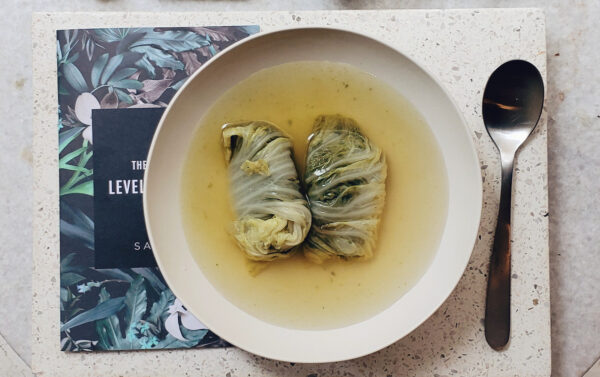Reading Time: 6 minutes
If you are interested in detoxification and cleansing your body you probably already give a lot of attention to avoiding toxins in food and trying to eat organic. But have you ever considered the possibility that your clothing might be a potential source of toxic compounds?
It can be surprising how even the most health-conscious people are lacking awareness about how clothes can contain toxins that have a negative impact on well-being. This is something I also only really began to realize just a few years ago, as I learned more about detoxification and healing and attempting to eliminate exposure to as many toxins from my environment as possible.
Chemicals in Laundry Detergents
Firstly, most laundry detergents contain fragrances and other toxic chemicals that are a hazard to everyone, but in particular, can cause problems for those with multiple chemical sensitivity. Dry cleaning especially is known for the use of carcinogenic compounds – the major one being perchloroethylene(PERC), which has been associated with migraines, nausea, respiratory irritation, organ damage, and more. The solution is to launder your own clothes with natural laundry detergent, and if you absolutely must, use a dry cleaner look for an eco-friendly or green establishment that does not use PERC. Soap nuts are probably the most natural and safest option for washing your clothes.

The Dangers of Synthetic Fabrics
The next thing to consider is the actual fabric that your clothing is made out of. Synthetic textiles like polyester, nylon, spandex, lycra, and acrylic are essentially plastic. So if you’ve ditched the plastic water bottles to avoid BPA but are wearing synthetic clothing, these toxins can still be entering your body through your skin.
Wearing these fabrics in high temperatures and high humidity environments can make the effects even worse by increasing absorption. The US Army actually forbids soldiers in the Middle East from wearing synthetics after many episodes of burns due to polyester, nylon, and acrylic clothing melting in the high temperatures. Scientific studies also show that wearing synthetic fibers causes muscle fatigue and synthetic undergarments may decrease sperm count and lead to infertility in men.
Our skin is also one of our major organs for detoxification and the primary way that we can eliminate these fat-soluble toxins is through sebaceous and sweat glands in the skin. However, petrochemical fibers don’t allow your skin to breathe, which shuts down the release of toxins, essentially trapping them inside your body.
The process of textile production also involves the use of more toxic chemicals which are often bonded to the fabric fibers by use of heat, leaving residues that stay in the clothing. According to fashion designer Eileen Fisher, “The clothing industry is the second-largest polluter in the world … second only to oil.”
Rayon is a semi-synthetic fabric made from recycled wood pulp that must be heavily treated with chemicals like caustic soda, ammonia, acetone, and sulphuric acid to survive regular washing and wearing. Even bamboo and soy, which are promoted as eco-friendly fabrics, usually involve a chemically-intensive production process, although there is some bamboo on the market that is produced by more sustainable methods.
Some of the worst offenders are black and blue-dyed synthetic clothing, which contain chemicals classified as carcinogens based on high rates of tumors in animal research and these chemicals cannot be removed by washing your clothes.

Are Natural Fabrics A Safe Option?
Clothing made from natural fibers such as cotton, hemp, and linen are a better choice because they allow your skin to breathe. They are also naturally antimicrobial and antibacterial and generally effective for thermal regulation.
However, these fabrics also usually undergo processing that can involve the use of toxic, petrochemical dyes, formaldehyde, dioxin, volatile organic compounds, chemical fabric softeners, flame retardants, anti-wrinkle compounds, anti-bacterial and fungicidal chemicals, and phthalates, all of which have been linked to major health issues.
In very sensitive individuals these chemicals can cause skin irritation, headaches, and breathing problems. Some of these irritants can be washed out but may require several launderings to bring the chemicals to a tolerable level. Unfortunately, some of these substances leave a residue and are never totally removed from the garment.
Remember that whatever goes on your skin is absorbed into your body. So when you wear toxic clothing these chemicals are absorbed through your skin and enter the lymphatic system. The body doesn’t have an effective method of detoxifying these chemical compounds so, for the most part, they are stored away in our fatty tissues.
The Truth About Cotton
Cotton especially is of concern due to its heavy use of pesticides. Although cotton covers 2.5 percent of cultivated land it is responsible for the use of 22.5 percent of the world’s pesticides. 80 percent of these have been classified as moderately to highly hazardous by the World Health Organization. In addition, up to 98 percent of conventionally grown cotton is genetically modified. By-products of cotton production are also used as food additives, vegetable oils, as fodder for animals raised for meat and dairy production and even in some vitamin supplements.
Thus cotton production poses dangers on so many levels – especially for the agricultural workers, those living nearby, individuals wearing cotton clothing containing chemical residues, and those who are unwittingly consuming pesticide-laden GMO cotton by-products in their food – as well as having a devastating impact on the environment as a whole.
Even though research shows that most of the pesticides are washed away during the manufacturing process, a variety of toxic chemicals, oils, and waxes are used in the creation of cotton garments and some of these may leave residues that can cause issues for those who are chemically sensitive.

Organic Fabrics Are The Best Choice
With the rise in consumer awareness, there are many more companies offering organic cotton clothing. Even though the cotton is grown without pesticides, unfortunately, this does not guarantee that the clothing is toxin-free as it can still be finished with harmful dyes and chemicals. There also is the environmental impact to consider as it can take more than 5,000 gallons of water to manufacture just one t-shirt and a pair of jeans.
Hemp can be a good option as it doesn’t require the use of pesticides, fertilizers or other chemicals. However, hemp produced in China may sometimes involve the application of chemicals to speed the harvesting process. Other natural fabrics to consider include linen and ramie and – if you are not an ethical vegan – silk, wool, cashmere, and alpaca. Tencel is a fabric similar to rayon, however, it is grown sustainably and the finished product contains no harmful substances.
The gold standard in organic clothing and fabrics are those that are GOTS certified, which considers the entire textile production process, instead of simply whether the raw materials were grown without pesticides. GOTS certified products also ensure that all employees must have fair working conditions and do not allow inhumane treatment of animals. Oeko-Tek is another certification that is less stringent but restricts the majority of dangerous chemicals. You can also look for fabrics that are organic and dyed with natural plants or undyed as these are less likely to contain chemical residues.

How to Detox Your Wardrobe
It can be overwhelming to attempt to overhaul your entire wardrobe – yet alone expensive! In the last few years, I’ve become much more aware of the eco-fashion industry and there are very few brands I’ve come across that use GOTS certified fabrics. So it can be a challenge to find clothing that you like to wear that is also organic and sustainable.
I do my best to focus on organic clothing and natural fibers but there are some garments like leggings, yoga pants and underwear that fit better with a little bit of stretch, so in those instances, I might compromise for a garment that is 95 percent organic cotton and 5 percent spandex. I do also sometimes buy garments that are pure linen or cotton but not necessarily organic. Jeans are one of the most versatile pieces of clothing in everyone’s wardrobe and I love wearing denim but still haven’t been able to find a brand making organic in my size. I also really appreciate natural dyes but they do tend to have an imperfect finish and can fade very quickly, so it might not be appropriate if you need a more polished look for a work environment. Consider your needs and strike a balance to create a wardrobe that will work for you.
I suggest you start with undergarments and sleepwear as these are closest to your skin and have the most potential impact. Then you can gradually replace the other items in your wardrobe as you can afford to do so. The first item to go should be synthetic fabrics.
If you have clothing made from cotton or other natural fibers it might be better to hang onto them rather than to purchase brand new items when you consider the impact on the environment. Additionally, many organic garments do still contain chemical residues that can take numerous washes to remove so the clothes you already have owned for a while can in many cases be less toxic than a brand new organic garment.
When you do purchase new items look for those of high quality and versatility that will last for years. Buying less clothing in general not only will reduce your toxic exposure but also reduces the impact on the environment. Sustainable clothing might be more expensive but it will probably last much longer than a cheaply produced garment, so ultimately you will end up spending less when you consider how much wear you will actually get out of your clothes.
References:
http://www.ethicalfashionforum.com/the-issues/pesticides
http://articles.mercola.com/sites/articles/archive/2016/10/12/toxic-clothing-chemicals.aspx
http://totalhealthmagazine.com/Allergies-Asthma/Consumers-Beware-Toxins-Lurking-in-Your-Clothing.html
https://www.sciencedaily.com/releases/2015/10/151023084508.htm
Disclosure: This article contains Amazon affiliate links, which means that if you click on a link and purchase a product the price remains the same for you but I receive a small commission. Thank you for supporting Live Remedy.



Hi, Very nice information. I was never really looking at clothing from the point of view of causing the increased toxicity of my body, but it makes sense! In regards to organic materials – I agree 100% with you! We wear only 100% organic, clothing from sustainable, independent brands which use toxic-free dyes.